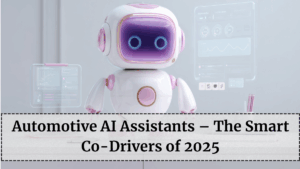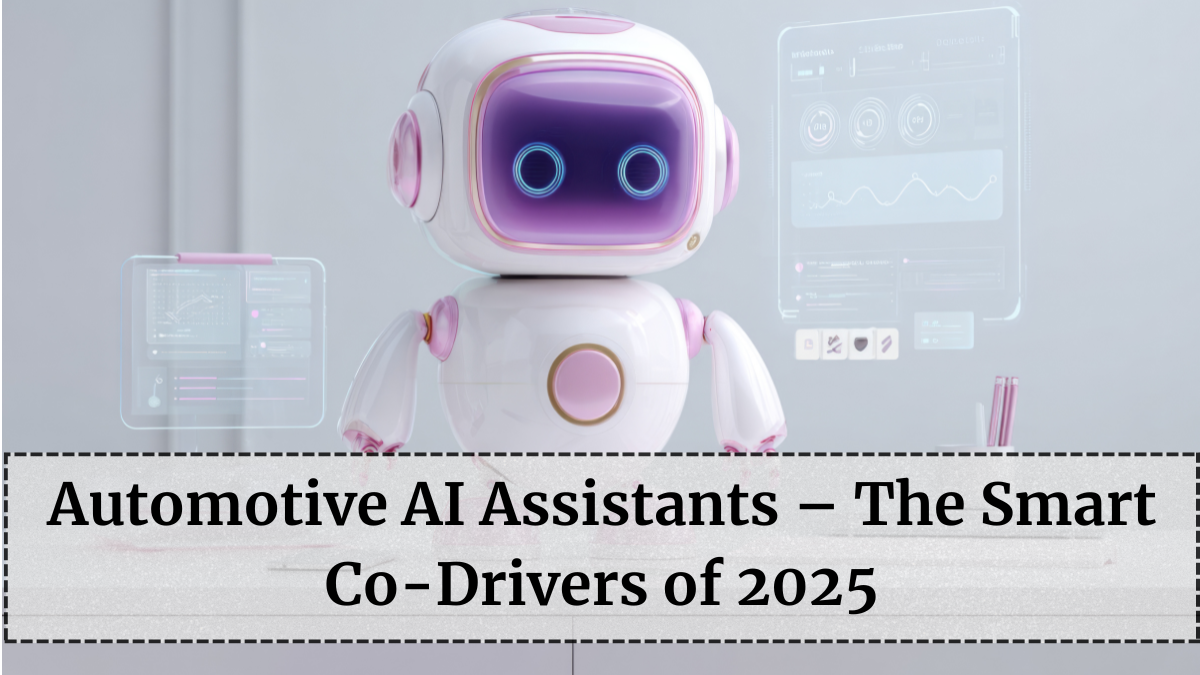Cars in 2025 are no longer just machines — they’re intelligent companions. With the rise of Automotive AI Assistants, drivers now experience personalized, voice-controlled, and emotion-aware journeys. These AI co-drivers combine natural language processing, predictive behavior, and connected car intelligence to make driving smarter and safer than ever before.
From luxury brands like Mercedes and BMW to mainstream automakers such as Tata and Hyundai, almost every car manufacturer has integrated AI assistants into their latest models. These virtual co-drivers can handle navigation, adjust vehicle settings, analyze driver fatigue, and even hold natural conversations — marking a new era of intelligent mobility.
Let’s explore how AI assistants are transforming the automotive experience in 2025.

What Are Automotive AI Assistants?
The Concept
Automotive AI Assistants are voice-activated digital systems built into vehicles that use artificial intelligence to interact with drivers. They process natural language commands, learn from driver habits, and integrate with vehicle systems and cloud data to offer real-time support.
Unlike traditional infotainment systems, these assistants understand context and emotion, allowing them to personalize everything from cabin temperature to the music playlist — all through conversation.
The Technology Behind It
Modern AI assistants combine:
-
Natural Language Processing (NLP): To understand human speech accurately.
-
Machine Learning (ML): To adapt and learn user behavior over time.
-
Edge Computing: Enables fast, on-device responses without internet dependency.
-
Cloud Connectivity: Accesses data like traffic, weather, or route optimization in real time.
Together, these technologies make cars responsive, conversational, and proactive.
Top Automotive AI Assistants in 2025
1. Mercedes-Benz MBUX Hyperscreen
The MBUX AI system remains one of the most advanced in 2025. Spanning the entire dashboard, the Hyperscreen uses voice recognition and emotional intelligence to deliver an intuitive driving experience.
Features:
-
Learns driver routines (seat position, routes, preferences).
-
“Hey Mercedes” voice command for every function.
-
Integrates with smart homes via Alexa and Google Home.
2. BMW Intelligent Personal Assistant
BMW’s AI assistant acts like a personal butler on wheels, responding to phrases like “Hey BMW, I’m tired.” It then automatically adjusts lighting, opens windows slightly, or plays energetic music.
Features:
-
Emotion-sensing AI through driver camera.
-
Predictive climate and route control.
-
Connected ecosystem via MyBMW app.
3. Hyundai’s SmartSense AI Assistant
In India, Hyundai’s SmartSense system has gained popularity for blending affordability with innovation.
Features:
-
Natural Hindi and English voice support.
-
Integration with regional navigation and entertainment apps.
-
Real-time vehicle diagnostics and safety alerts.
4. Tata Motors’ ZConnect AI
Tata Motors is leading India’s AI mobility drive with its ZConnect AI, offering intuitive control through touch, voice, and smartphone sync.
Features:
-
Command-based voice assistance for navigation, climate, and calls.
-
EV range estimation using AI prediction.
-
Emergency SOS and battery management integration.
5. Tesla Autopilot + AI Voice Interface
Tesla’s system continues to evolve with neural network-powered interaction that syncs with its self-driving features.
Features:
-
Conversational updates about traffic and battery.
-
Integration with Full Self-Driving (FSD) modules.
-
Predictive command recognition using long-term user data.
Key Features of Automotive AI Assistants
1. Voice-Activated Commands
Drivers can perform hands-free actions such as controlling air conditioning, navigating destinations, or sending messages. Modern AI assistants recognize multiple accents and languages, ensuring inclusivity across regions.
2. Predictive Personalization
The assistant anticipates user needs based on driving history. For example, it might suggest charging stops, coffee breaks, or playlist changes based on time and routine.
3. Driver Monitoring & Safety
AI cameras track eye movement, heart rate, and posture to detect fatigue. If drowsiness is detected, the assistant issues alerts or suggests rest stops.
4. Smart Navigation and Connectivity
Integrated with cloud-based systems, the assistant provides real-time traffic data, weather forecasts, and even updates from connected smart home devices.
5. Entertainment and Mood Adaptation
AI adjusts lighting, sound, and display themes according to mood. Some vehicles feature emotion-adaptive music curation, syncing playlists with facial expressions or tone of voice.
AI Assistants in EVs – Smarter Energy Management
Electric vehicles benefit even more from AI integration. Assistants in EVs help drivers:
-
Predict charging station locations based on range and route.
-
Recommend optimal driving modes to conserve energy.
-
Schedule charging during off-peak hours to save costs.
Brands like MG, BYD, and Kia now provide AI-driven eco reports, showing drivers how their habits affect range and battery life.
The Impact on Automotive Jobs and Service
AI assistants have also created new career paths in AI UX design, automotive NLP, and vehicle software engineering. Service centers now use AI systems for predictive diagnostics and remote troubleshooting, reducing downtime for vehicle owners.
In 2025, over 60% of premium and mid-segment cars come with built-in AI assistants, while aftermarket systems are available for older models through Android Auto and Alexa Auto integration.
Future of Automotive AI Assistants
By 2030, car AI assistants are expected to evolve into full cognitive copilots capable of autonomous decision-making. Future systems may:
-
Detect road rage or stress in drivers and intervene.
-
Communicate with other cars for cooperative navigation.
-
Offer multilingual emotional support for long trips.
The long-term goal is zero-distraction driving, where AI takes care of everything — from safety to comfort — allowing humans to focus solely on the journey.
FAQs
What are automotive AI assistants?
They are AI-powered virtual co-drivers that perform voice-controlled tasks, provide navigation, monitor safety, and personalize in-car experiences.
Do AI assistants work offline?
Many modern assistants use edge computing, allowing limited offline functionality for basic tasks like AC or lighting control.
Which car brands offer AI assistants in India?
Tata, Hyundai, MG, Kia, and BMW currently offer voice AI integration in their latest EVs and premium vehicles.
Are automotive AI assistants safe to use while driving?
Yes, they’re designed for hands-free operation to minimize distractions and improve driver focus.
What’s next for in-car AI technology?
Expect emotion-aware assistants, multi-lingual natural conversations, and self-learning copilots by the end of the decade.
Click here to know more.
